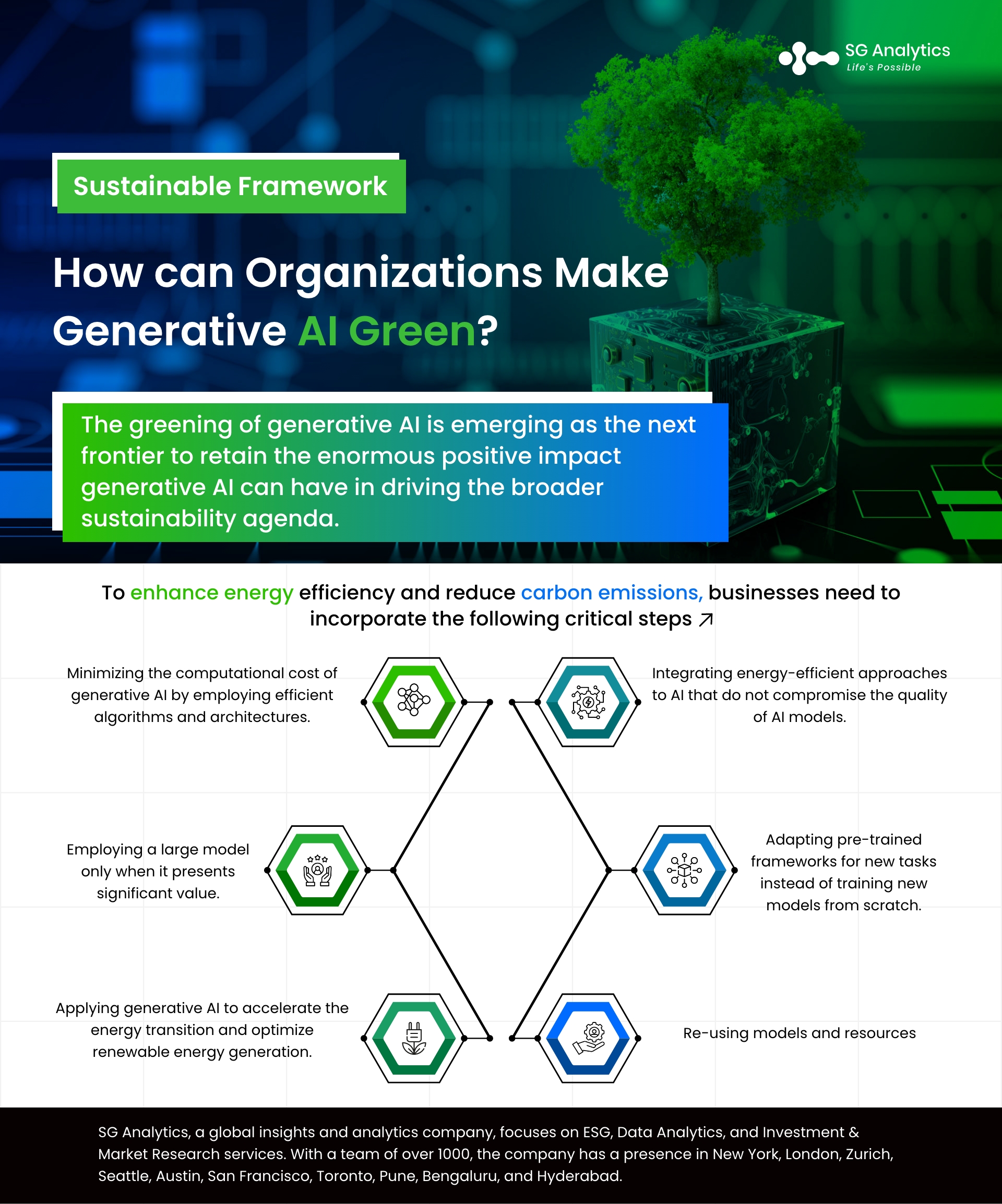Today, generative AI applications are capturing the imagination of the public and are being perceived as the fastest-growing consumer applications in history. This critical rise of generative AI has ushered businesses into a new era of innovation and technological advancement. However, it is taking a toll on the environment.
They are proving to be a remarkable tool to address the most complex global challenges. The development and use of these AI systems are hugely energy-intensive, and maintaining the infrastructure entails power consumption. With generative AI tools beginning to gain mainstream traction, it is reasonable to think that the associated costs are poised to grow dramatically in the near future.
Almost all of the best-known generative AI models run on graphics processing unit (GPU) chips that require 10–15 times the energy a traditional CPU needs. Today, the three main hyperscale cloud providers available in the market are Amazon AWS, Google Cloud, and Microsoft Azure.
Read more: ESG Outlook: How Tech Companies Harness Data to Reimagine Their Business
Determining the Carbon Footprint of Generative AI Models
Generative AI models are not alike when it comes to energy use and carbon emissions. When determining the carbon footprint of any GenAI model, there are three distinct values to take into consideration:
-
the carbon footprint generated from training the model
-
the carbon footprint generated from running inference when the model has been deployed
-
the carbon footprint required to create all of the needed computing hardware as well as cloud data center capabilities

GenAI models with parameters and training data often consume more energy and generate more carbon footprint. Training ML models are considered the most energy-intensive components of generative AI. The new generation of models requires a ten to a hundred-fold increase in computing power in order to train the ML models. And this demand has been doubling about every six months.
Enhancing the output of large language models (LLMs) has become an indispensable part of today's modern generative AI landscape. In the context of sustainability, it has become critical for businesses to operate in tandem with principles such as Continuous Intelligence, Feedback Management, and Continuous Integration. These elements help improve not only the model's performance but also its sustainability.
-
Continuous Intelligence: Constant data input helps the model to adapt and improve. A continuously intelligent model requires fewer resources to generate accurate outputs.
-
Feedback Management: Real-time feedback assists in dynamically adjusting the performance metrics of any AI model. This continuous refinement further ensures that the model's effectiveness is consistently high, thereby reducing the computational load as well as power consumption.
-
Continuous Integration: By seamlessly integrating new features and capabilities, the model can be tailored to specific tasks, thus reducing errors and refining their efficiency. This will ensure that only relevant and optimized data is fed into the model, thus reducing the wastage of computational resources.
Read more: What is a Carbon Offset, and How Does it Work?
By integrating continuous intelligence, feedback management, and continuous integration, businesses can significantly enhance the performance of their model while reducing their environmental footprint. This approach will further facilitate a structured pathway to making generative AI more sustainable without compromising on its capabilities.
Generative AI holds huge potential to drive the ESG and sustainability agenda for businesses, enabling them to enhance climate action, drive responsible production, and protect sensitive data. However, to address both the environmental and operational aspects of generative AI, it has become vital for businesses to introduce frameworks that offer a comprehensive sustainable strategy for growth.

Make Generative AI Greener
The greening of generative AI is emerging as the next frontier to retain the enormous positive impact generative AI can have in driving the broader sustainability agenda. There is an ongoing movement to make AI modeling, deployment, and usage more environmentally sustainable. The goal is to replace power-hungry approaches with environmentally conscious replacements. And to make AI algorithms green, a change is needed from both vendors and users. Their utility can be deployed without harming the environment. There is a growing need for generative AI models to become greener before they become more pervasive.
To enhance energy efficiency as well as reduce carbon emissions throughout the AI development and operations cycle, businesses need to incorporate critical steps. They are-
-
Minimizing the computational cost of generative AI by employing efficient algorithms, architectures, and hardware
As a first step, organizations need to develop or adopt accurate energy estimation approaches that are non-invasive, vendor-agnostic, and have comprehensive hardware coverage. This will help in reducing the time and energy directed for training and deployment, thus resulting in reduced emissions and costs.
-
Integrating energy-efficient approaches to AI doesn’t require significant compromises on the quality of AI models
The carbon footprint of large language models can be reduced with the appropriate choice of algorithms, customized hardware, and energy-efficient data centers.
Read more: Integrating AI for Inclusive Fintech Across the Industry
-
Employing a large model only when it presents significant value
It is essential for data scientists and developers to understand when and where the GenAI model will provide value. If the usage of a 3x more power-hungry system increases the accuracy of a model by just 1–3%, then employing a larger model is not worth the extra energy consumption. It is equally important to note that machine learning and artificial intelligence are not always required to solve a problem. Developers need to undertake research and analysis of available alternative solutions in order to select an approach based on the findings.

-
Adapting pre-trained frameworks for new tasks instead of collecting new data or training new models from scratch
Where possible, businesses can fine-tune their pre-trained frameworks at a fraction of the cost and emissions required to build a new model. By reducing the size as well as complexity of these models, organizations can shrink their energy consumption and carbon footprint.
-
Integrating energy-conserving computational methods
Another significant approach to reducing generative AI energy consumption is to use less computationally expensive approaches. These frameworks enable users to execute their ML models on small and low-powered edge devices with low bandwidth requirements.
-
Applying generative AI to accelerate the energy transition and optimize renewable energy generation and distribution
Applying generative AI to the energy sector can help companies reduce their greenhouse gases while also increasing energy efficiency and creating new low-carbon innovations. Generative AI can be employed to predict energy demand and boost the production of renewable energy by optimizing design based on weather patterns.
-
Re-using models and resources
Just like any other material, tech can also be reused. Open-source prototypes can be used instead of training new ones. Recycling can help businesses lower the impact of carbon-producing AI practices. Raw materials can be extracted to make newer generations of processors, hard drives, and much more.
Read more: Big Tech’s Big Generative AI FOMO

Final Thoughts
There are many ethical, legal, philosophical, and psychological considerations involved with the use of generative AI models. However, ecological concerns are worthy of being added to this mix. For the long-term future implications of these technologies on humanity, businesses need to incorporate such considerations. With generative AI becoming more prevalent, it is critical for businesses and communities to establish a reliable network of tools and practices. It further presents businesses with new opportunities and risks for sustainability. While relying on innovative technology to address the most pressing challenges, it is crucial for them to proactively implement measures and mitigate potential drawbacks.
By adopting a strategic approach to sustainability, businesses can reduce their environmental footprint and also contribute to a positive societal impact. With sustainability becoming an increasingly critical factor in decision-making, it has become vital for businesses to integrate it into their AI strategy in order to position themselves as a responsible and forward-thinking leader.
SG Analytics, recognized by the Financial Times as one of APAC's fastest-growing firms, is a prominent insights and analytics company specializing in data-centric research and contextual analytics. Operating globally across the US, UK, Poland, Switzerland, and India, we expertly guide data from inception to transform it into invaluable insights using our knowledge-driven ecosystem, results-focused solutions, and advanced technology platform. Our distinguished clientele, including Fortune 500 giants, attests to our mastery of harnessing data with purpose, merging content and context to overcome business challenges. With our Brand Promise of "Life's Possible," we consistently deliver enduring value, ensuring the utmost client delight.
A leader in ESG Services, SG Analytics offers bespoke sustainability consulting services and research support for informed decision-making. Contact us today if you are searching for an efficient ESG (Environmental, Social, and Governance) integration and management solution provider to boost your sustainable performance.
About SG Analytics
SG Analytics is an industry-leading global insights and analytics firm providing data-centric research and contextual analytics services to its clients, including Fortune 500 companies, across BFSI, Technology, Media & Entertainment, and Healthcare sectors. Established in 2007, SG Analytics is a Great Place to Work® (GPTW) certified company and has a team of over 1100 employees and has presence across the U.S.A, the U.K., Switzerland, Canada, and India.
Apart from being recognized by reputed firms such as Analytics India Magazine, Everest Group, and ISG, SG Analytics has been recently awarded as the top ESG consultancy of the year 2022 and Idea Awards 2023 by Entrepreneur India in the “Best Use of Data” category.









